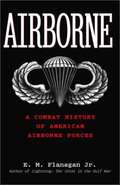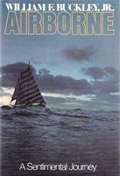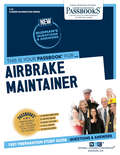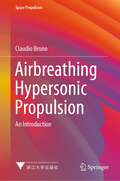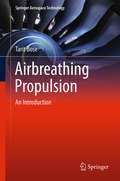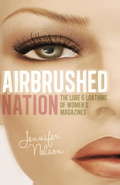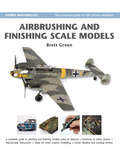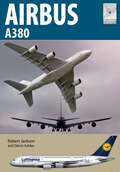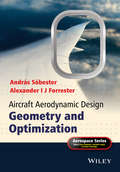- Table View
- List View
Airborne: A Combat History of American Airborne Forces
by Edward M. Flanagan Jr.A combat history of American airborne forces up to the Gulf War.
Airborne: A Sentimental Journey
by William F. Buckley Jr.Excerpts from the ship's log as Buckley sails across the Atlantic Ocean with his son and some friends, along with his musings on sailing and seamanship.
Airborne: Assault From the Sky
by Hans HalberstadtThey are fighting men of legendary courage. Volunteers who submit to the most brutal training the army has to offer--they are airborne warriors who jump from planes into the heart of combat, fully armed and ready to fight the moment they touch ground. The men of the airborne wear their wings with pride, for they are symbols earned with sweat and blood. Now, author/photographer Hans Halberstadt takes you into the lives of America's airborne soldiers. Follow these fearless men from their intensive ground training to airborne action. 1988.
Airbrake Maintainer: Passbooks Study Guide (Career Examination Series #C-12)
by National Learning CorporationThe Airbrake Maintainer Passbook® prepares you for your test by allowing you to take practice exams in the subjects you need to study. It provides hundreds of questions and answers in the areas that will likely be covered on your upcoming exam, including but not limited to: Mechanical and pneumatic principles and devices; Installation, testing, maintenance and repair of such devices; Reading and understanding mechanical and pneumatic manuals and drawings; safe work practices and procedures; and other related areas.
Airbreathing Hypersonic Propulsion: An Introduction (Space Propulsion)
by Claudio BrunoThis book details science of hypersonics especially focusing on propulsion aspects such as supersonic combustion ramjets and their applications, and also includes lift and drag in hypersonic flight and their mathematical and physical explanation. It provides charts and data from hypersonic testing and measurements from actual vehicles and engines built in the past. Criteria to dimension hypersonic powered and unpowered vehicles (gliders) based on fundamental fluid dynamics and backed by flight testing; criteria to preliminary sizing vehicles and preliminary dimensioning of supersonic combustors are introduced. The book will serve better theoretical understanding of drag, lift and how to apply them to the design of hypersonic vehicles, as well as data to size vehicles and supersonic combustion ramjet (SCRJ) systems. This book will be a useful reference for researchers and designers in hypersonic vehicles but also second or third-year graduate students.
Airbreathing Propulsion: An Introduction (Springer Aerospace Technology)
by Tarit BoseAirbreathing Propulsion covers the physics of combustion, fluid and thermo-dynamics, and structural mechanics of airbreathing engines, including piston, turboprop, turbojet, turbofan, and ramjet engines. End-of-chapter exercises allow the reader to practice the fundamental concepts behind airbreathing propulsion, and the included PAGIC computer code will help the reader to examine the relationships between the performance parameters of different engines. Large amounts of data have on many different piston, turbojet, and turboprop engines have been compiled for this book and are included as an appendix. This textbook is ideal for senior undergraduate and graduate students studying aeronautical engineering, aerospace engineering, and mechanical engineering.
Airbrushed Nation: The Lure and Loathing of Women's Magazines
by Jennifer NelsonGlamour. Cosmo. SELF. Ladies’ Home Journal. Vogue. In an industry that has been in a downward spiral for years, these magazines-and other women-focused magazines like them-have not only retained their readership, they’ve increased it. Every month, five million-plus women peel back the slick cover of their favorite magazine to thumb through pages filled with tidings and advice about fashion, beauty, sex, relationships, dieting, health, and lifestyle. But do women’s magazines offer valuable information, or do they merely peddle fluff and fantasy-and in either case, do women take their messages to heart? InStiletto Nation,Jennifer Nelson-a longtime industry insider-exposes the naked truth behind the glossy pages of women’s magazines, both good and bad. Nelson delves deep into the world of glossies, explaining the ways in which these magazines have been positive for women, highlighting the ways in which their agendas have been misguided, and asking the questions that have long gone unasked: What do women think and believe about the retouched photos, the ubiquitous sex advice, the constant offensive on aging, and the fantasy fashion spreads featuring unaffordable clothing and accessories? Do the unrealistic ads, images, and ideals that permeate glossies damage women’s self-esteem . . . and is it intentional?
Airbrushing and Finishing Scale Models
by Brett GreenA convincing paint finish is essential for any model, be it military or civilian, aircraft, vehicles, figures or even background items such as terrain or buildings - and good airbrushing and finishing techniques can be the key to creating a superior model. Over the last few years there have been huge strides made in the development of airbrushes, paints and thinners, and consequently, this new book will provide up-to-date practical information and illustrated techniques to take full advantage of these new technologies.Brett Green details the prerequisites of airbrushing, including the different types of spray equipment and air sources available, offering advice on appropriate thinners, paint ratios and air pressures to ensure the most appropriate paint coverage across a range of different airbrushing applications. He then examines various airbrushing techniques across a wide range of models. Ten step-by-step, illustrated case studies ranging from heavily weathered military aircraft to pristine, high gloss motor vehicles, science fiction models, fantasy figures, groundwork and buildings will complete this in-depth guide to getting the best results on your models.From the Hardcover edition.
Airbus A380 (Flight Craft #23)
by Robert Jackson Glen Ashley“A great addition to the highly popular Flight Craft Series. This book reviews the history of . . . an iconic and important aircraft in civil aviation.” —FiretrenchOn April 27 2005, an aircraft under the power of six massive Rolls-Royce Trent 900 turbofan engines was making its first flight, and it was making history. For this was the Airbus A380, the largest passenger aircraft in the world. With air traffic continuing to double every fifteen years, the A380 was designed by Airbus Industrie to meet the needs of the passengers and airports, while also delivering the level of efficiency necessary to protect the environment for future generations. The design incorporated two full-length decks with wide-body dimensions, meaning its two passenger levels offered an entire deck’s worth of additional space compared to the next largest twin-engine jetliner. With more seats than any other aircraft, the A380 offered solutions to overcrowding; needing fewer journeys to carry 60 percent more passengers, making it the perfect solution to airport congestion, fleet planning optimization and traffic growth. Typical seating capacity was 525, although the aircraft was certified to carry up to 853 passengers. Production of the A380 peaked at thirty aircraft per year in 2012 and 2014. Then, in February 2019, the biggest customer, Emirates, announced that it was to reduce its latest order by thirty-nine aircraft in favour of two other Airbus Models, the A350 and A330neo, a version using the same engines as the Boeing 787 Dreamliner. For Airbus, it was the last act. The Company announced that production of the A380 would cease by 2021.“Full of great information.” —Airport Spotting
Airbus A3XX: Developing the World's Largest Commercial Jet (A)
by Michael Kane Benjamin C. EstyIn July 2000, Airbus Industries' supervisory board is on the verge of approving a $13 billion investment for the development of a new super jumbo jet known as the A3XX that would seat from 550 to 1,000 passengers. Having secured approximately 20 orders for the new jet, the board must decide whether there is sufficient long-term demand for the A3XX to justify the investment. At the time, Airbus was predicting that the market for very large aircraft (VLA), those seating more than 500 passengers, would exceed 1,500 aircraft over the next 20 years and would generate sales in excess of $350 billion. According to Airbus, it needed to sell 250 aircraft to break even and could sell as many as 750 aircraft over the next 20 years. This case explores the two sets of forecasts and asks students whether they would proceed with the launch given the size of the investment and the uncertainty in long-term demand.
Airbus A3XX: Developing the World's Largest Commercial Jet (B)
by Michael Kane Benjamin C. EstySupplements the (A) case.
Airbus versus Boeing (A)
by Ramon Casadesus-Masanell Eric Van Den SteenLooks at the development of the competitive actions between Airbus and Boeing from 1992 to 2006. Begins with the question of whether Airbus and Boeing should collaborate on the development of a VLCT (Very Large Commercial Transport) or whether Airbus should develop their own. The case series moves through to the events thereafter of Airbus' decision to pursue the A380 and Boeing's decision relating to developing a stretch 747.
Airbus versus Boeing (A)
by Ramon Casadesus-MasanellLooks at the development of the competitive actions between Airbus and Boeing from 1992 to 2006. Begins with the question of whether Airbus and Boeing should collaborate on the development of a VLCT (Very Large Commercial Transport) or whether Airbus should develop their own. The case series moves through to the events thereafter of Airbus' decision to pursue the A380 and Boeing's decision relating to developing a stretch 747.
Airbus vs. Boeing (A)
by Ramon Casadesus-Masanell Jordan Mitchell Erich Alexander VoigtLooks at the development of the competitive actions between Airbus and Boeing from 1992 to 2006. Begins with the question of whether Airbus and Boeing should collaborate on the development of a VLCT (Very Large Commercial Transport) or whether Airbus should develop their own. The case series moves through to the events thereafter of Airbus' decision to pursue the A380 and Boeing's decision relating to developing a stretch 747.
Airbus vs. Boeing (A): Turbulent Skies
by Malcolm S. Salter Irence L. SinrichPresents the economic and political dimensions of competition in the commercial aircraft industry, as demonstrated by Airbus of Europe and Boeing of the United States.
Airbus vs. Boeing (B): Should Airbus Build the VLCT Alone?
by Ramon Casadesus-Masanell Jordan MitchellAn abstract is not available for this product.
Airbus vs. Boeing (G): New Planes and Upgrades (2011)
by Ramon Casadesus-Masanell Karen EltermanThis case describes the first commercial flight of Boeing's 787 Dreamliner in 2011, three years after originally planned, as well as the first commercial flight of Airbus's superjumbo, the A380, in 2007. It also describes the companies' current endeavors in 2011, including Airbus's work on the A350 and A320neo and Boeing's development of the 737 MAX.
Airbus vs. Boeing (G): The Dreamliner Takes to the Skies (2011)
by Ramon Casadesus-Masanell Karen EltermanThis case describes the first commercial flight of Boeing's 787 Dreamliner in 2011, three years after originally planned, as well as the first commercial flight of Airbus's superjumbo, the A380, in 2007. It also describes the companies' current endeavors in 2011, including Airbus's work on the A350 and A320neo and Boeing's development of the 737 MAX.
Airbus vs. Boeing (H): Wing Cracks and Battery Fires (2013)
by Ramon Casadesus-Masanell Karen EltermanThis case describes an issue with the batteries of Boeing's 787 Dreamliner planes overheating and sometimes catching fire in 2013. The planes were grounded for several months until Boeing introduced new safety measures. The case also discusses a problem with cracks on the wings of Airbus's A380 superjumbo, which required the company to make a costly fix to a particular wing component.
Airbus vs. Boeing (I): Airbus Introduces the A350 (2015)
by Ramon Casadesus-Masanell Karen EltermanThis case describes the introduction of Airbus's A350XWB (Xtra Wide Body) in 2015. It also describes Airbus and Boeing's current endeavors in 2015, including Airbus's development of the A330neo, Boeing's work on the 737 MAX, and Boeing's announcement of the 777X.
Airbus vs. Boeing (J): New Plane Developments (2016)
by Ramon Casadesus-Masanell Karen EltermanThis case describes Airbus and Boeing developments in 2016, including Airbus's delivery of the first A320neo and Boeing's work on the 737 MAX and 777X programs. It also notes Airbus's restructuring in 2016.
Airbus vs. Boeing (K): New Partnerships (2018)
by Ramon Casadesus-Masanell Karen EltermanThis case describes Airbus's partnership with the Montreal-based aircraft manufacturer Bombardier beginning in 2017. The two companies partnered on the C Series of aircraft (later named the A220 Family), which consisted of small aircraft with 100-150 seats. The case also describes Boeing's 2018 joint venture with the Brazilian aerospace company Embraer, which produced the E2 Family of planes (97-120 seats).
Airbus vs. Boeing (L): Discontinuing the A380 (February 2019)
by Ramon Casadesus-Masanell Karen EltermanThis case describes Airbus's February 2019 announcement that it was ending production of the A380, with the last delivery scheduled for 2021. The announcement followed an order cancellation by Emirates, a major customer of the A380. The A380 had faced significant competition from Boeing's Dreamliner, and airlines had difficulty filling their A380s enough to make them fuel efficient and cost effective. Since the plane's launch, Airbus had sold far fewer A380s than it initially predicted.
Airbus vs. Boeing (M): MAX 8 Disasters (July 2019)
by Ramon Casadesus-Masanell Karen EltermanThis case describes the October 2018 and March 2019 crashes of Boeing MAX 8 jets, which together killed over 300 passengers. The planes involved in both crashes shared a problem with a software system called MCAS, which Boeing had revamped at the last minute prior to selling the planes, but had failed to mention in its pilot manuals until after the first crash. As of July 2019, the MAX 8 remained grounded worldwide. As the investigation into the MAX 8 continued, a simultaneous investigation into a Boeing 787 factory found that the company had repeatedly ignored reports of manufacturing defects and debris left on 787s from the factory.
Aircraft Aerodynamic Design
by Andr?s S?bester Alexander I ForresterOptimal aircraft design is impossible without a parametric representation of the geometry of the airframe. We need a mathematical model equipped with a set of controls, or design variables, which generates different candidate airframe shapes in response to changes in the values of these variables. This model's objectives are to be flexible and concise, and capable of yielding a wide range of shapes with a minimum number of design variables. Moreover, the process of converting these variables into aircraft geometries must be robust. Alas, flexibility, conciseness and robustness can seldom be achieved simultaneously.Aircraft Aerodynamic Design: Geometry and Optimization addresses this problem by navigating the subtle trade-offs between the competing objectives of geometry parameterization. It beginswith the fundamentals of geometry-centred aircraft design, followed by a review of the building blocks of computational geometries, the curve and surface formulations at the heart of aircraft geometry. The authors then cover a range of legacy formulations in the build-up towards a discussion of the most flexible shape models used in aerodynamic design (with a focus on lift generating surfaces). The book takes a practical approach and includes MATLAB®, Python and Rhinoceros® code, as well as 'real-life' example case studies.Key features: Covers effective geometry parameterization within the context of design optimizationDemonstrates how geometry parameterization is an important element of modern aircraft designIncludes code and case studies which enable the reader to apply each theoretical concept either as an aid to understanding or as a building block of their own geometry modelAccompanied by a website hosting codesAircraft Aerodynamic Design: Geometry and Optimization is a practical guide for researchers and practitioners in the aerospace industry, and a reference for graduate and undergraduate students in aircraft design and multidisciplinary design optimization.
